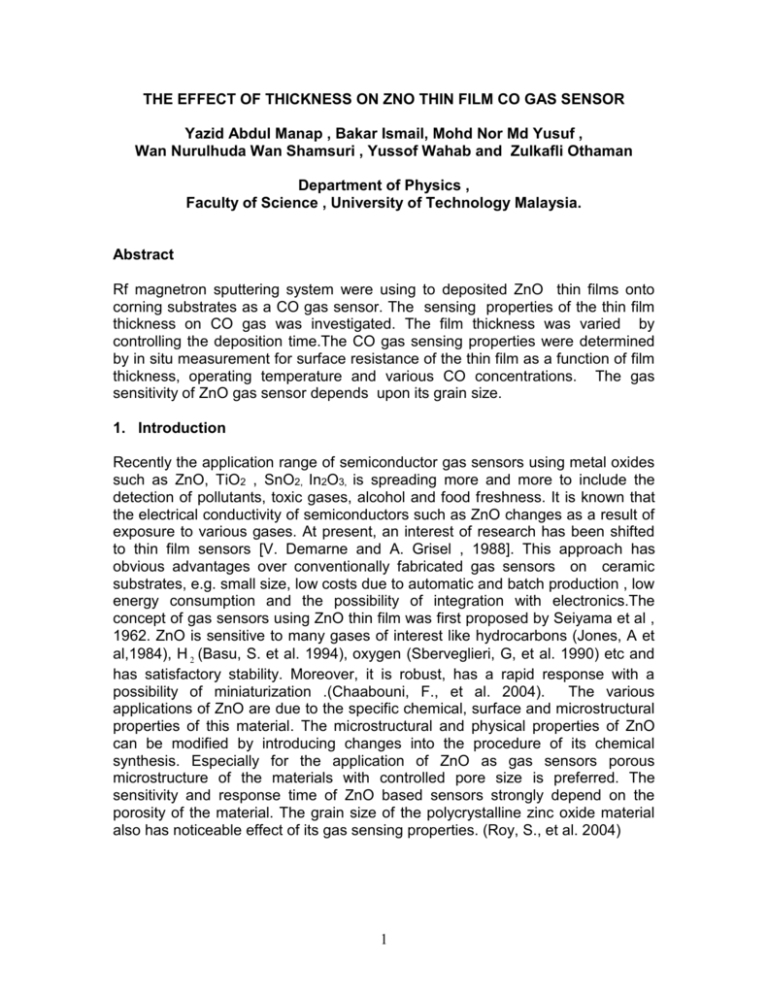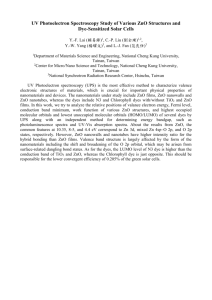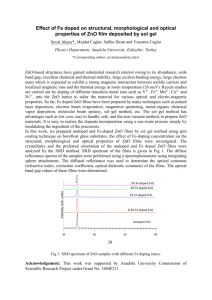The Effect Of Thickness On ZnO Thin Film CO Gas Sensor
advertisement

THE EFFECT OF THICKNESS ON ZNO THIN FILM CO GAS SENSOR Yazid Abdul Manap , Bakar Ismail, Mohd Nor Md Yusuf , Wan Nurulhuda Wan Shamsuri , Yussof Wahab and Zulkafli Othaman Department of Physics , Faculty of Science , University of Technology Malaysia. Abstract Rf magnetron sputtering system were using to deposited ZnO thin films onto corning substrates as a CO gas sensor. The sensing properties of the thin film thickness on CO gas was investigated. The film thickness was varied by controlling the deposition time.The CO gas sensing properties were determined by in situ measurement for surface resistance of the thin film as a function of film thickness, operating temperature and various CO concentrations. The gas sensitivity of ZnO gas sensor depends upon its grain size. 1. Introduction Recently the application range of semiconductor gas sensors using metal oxides such as ZnO, TiO2 , SnO2, In2O3, is spreading more and more to include the detection of pollutants, toxic gases, alcohol and food freshness. It is known that the electrical conductivity of semiconductors such as ZnO changes as a result of exposure to various gases. At present, an interest of research has been shifted to thin film sensors [V. Demarne and A. Grisel , 1988]. This approach has obvious advantages over conventionally fabricated gas sensors on ceramic substrates, e.g. small size, low costs due to automatic and batch production , low energy consumption and the possibility of integration with electronics.The concept of gas sensors using ZnO thin film was first proposed by Seiyama et al , 1962. ZnO is sensitive to many gases of interest like hydrocarbons (Jones, A et al,1984), H 2 (Basu, S. et al. 1994), oxygen (Sberveglieri, G, et al. 1990) etc and has satisfactory stability. Moreover, it is robust, has a rapid response with a possibility of miniaturization .(Chaabouni, F., et al. 2004). The various applications of ZnO are due to the specific chemical, surface and microstructural properties of this material. The microstructural and physical properties of ZnO can be modified by introducing changes into the procedure of its chemical synthesis. Especially for the application of ZnO as gas sensors porous microstructure of the materials with controlled pore size is preferred. The sensitivity and response time of ZnO based sensors strongly depend on the porosity of the material. The grain size of the polycrystalline zinc oxide material also has noticeable effect of its gas sensing properties. (Roy, S., et al. 2004) 1 2. Experimental In this study , commercially prepared ZnO powder (purity 99.9 were obtained from Sigma Aldrich Cheme GmbH Germany . The powder of ZnO were then dry-pressed or pelletised in 40 mm diameter stainless steel die (HERZOG Pelletising Press) with a minimum force of 10 kN and a maximum force 400 kN. A force of 50 kN (± 1 kN) was applied at ambient temperature for 10 minutes on the target and is equivalent to a calculatrd pressure on the target of about 40 MPa. The resultant disc shaped pellets have 40 mm ((± 0.01mm) diameter and of 20 g (± 0.1 g). The targets formed by compaction were sintered in an electric furnace (CARBOLITE) at temperatures 1000 ˚ C . The targets were first placed in the furnace at ambient temperature and the furnace was then turned on and set to the required sintering temperature. The heating rate of the furnace was set to. 20 ˚ C per minute. The targets were then maintained at elevated temperature for one hour after which the temperature of the furnace was allowed to cool down to the laboratory temperature at the same rate of 20 ˚ C per minute. The sintering time of one hour was selected in order to control this parameter in this study. ZnO thin films were fabricated by a rf magnetron sputtering method at an argon and oxygen gas pressure of 4 x 10-2 Torr. The substrate was corning glass and placed parallel to the target surface. The sputtering was carried out for 30 min under rf power of 100W. ZnO thin film was attached with comb-like electrodes from Aluminium. The heater was also fabricated using Platinum wire and put inside ceramic . Fig.1. Schematic Representation Of Gas Detection System 2 The sensitivity, S in the experiment is defined as S = Vg/Va (Guorui Dai , 1998) where Va and Vg are the voltage drop across the load resistance in air and testing gases respectivlely. Figure 2. EDAX spectrum of ZnO thin film 3. Results and discussion 3.1 Structural Characteristics The sensing mechanism of the semiconducting ZnO belongs to the surfacecontrolled type where the gas sensitivity is determined by the surface adsorption sites/area [N. Yamazoe, 1991]. The surface morphology varied with the film thickness significantly , therefore the total adsorption area exposed to the target gas may also vary as the film thickness [Van der Drift, 1967]. In this paper, the adsorption area as a function of ZnO film thickness was controlled by changing the deposition time of 30 , 60, 90, 120,150 , 180 min. The ZnO film thickness increased from 89nm to 510 nm when deposition time varied from 30 to 180 min As shown in Fig. 2, the spectra indicate that the prominent peak is the Zn line followed by O line. The other peak in the spectra is Au peaks from the Goldcoating treatment in preparation for SEM observation. 3 a b c Fig.3. SEM morphology of surface of ZnO films with various thickness (a) 89 nm (b) 240 nm (c) 425 nm The surface morphologies were shown in fig 3 for various ZnO film thickness. It is seen that the film smooth in morphologies with the grain size much more developed as the film thickness was increased. 3.2 Sensing Characteristics of the thin film sensors In general, the sensitivity of the sensor is affected by the operating temperature. The higher temperature enhances surface reaction of the thin films and gives higher sensitivity in a temperature range. 4 89 nm 165 nm 240 nm 328 nm 425 nm 510 nm 6 5 Sensitivity 4 3 2 1 0 50 100 150 200 250 Temperature ( 0 300 350 C) Fig.4. The relation between sensitivity and operation temperature of ZnO films under 2100 ppm CO atmosphere Fig 4 shows the sensitivity as a functions of operation temperature from 50 oC to 350oC for the various thickness of deposited Zinc Oxide film under 2100 ppm CO concenteration. A rapid increase in sensitivity was observed as the operation temperature was increased to 200oC and reached a maximum for the 89 nm films and decreased thereafter with further increase in operation temperature. It can be inferred from this observation that the sensitivity increased as the film thickness decreased and optimum operating temperature for 89 nm films is the lowest compare to other films. The sensitivity of the metal oxide semiconductor sensor is mainly determined by the interaction between the target gas and the surface of the sensor. The greater the surface area of the materials, the stronger the interaction between the adsorbed gases and the sensor surface , i.e. the higher the gas sensing sensitivity. It can be observed from SEM morphologies as shown in Fig.2 that the grain size is small in the 89 nm film while it is large in the 425 nm one and grain boundary are the largest when the film thickness is 89 nm in this study. 5 400 ppmCO 800 ppmCO 2100 ppmCO 8 7 6 Sensitivity 5 4 3 2 1 0 -1 0 2 4 6 8 10 Time (minute) Fig. 5. Transient responses of ZnO films (89 nm thick) for exposure to various CO concentration at 300 o C. The sensitivity as a function of CO gas concentration for the as deposited 89 nm ZnO at 300 o C is shown in Fig. 5. The sensitivity of the ZnO gas sensor increased as the CO gas concentration was increased from 400 to 2100 ppm and it dropped rapidly when the CO gas was removed , indicating that the gas sensor has a good response for different CO concentrations. Besides, it took almost the same time for the sensor to reach the maximum sensitivity for different CO concentrations. This result was consistent with the conclusion for the dominance of operation temperature for the response time. 200 ppmCO 400 ppmCO 600 ppmCO 800 ppmCO 2100 ppmCO 6 Sensitivity 5 4 3 2 1 50 100 150 200 Temperature ( 250 300 350 o C ) Fig.6. Relationship between gas sensitivity and operating temperature at various CO concentrations for 89 nm ZnO films. 6 Fig. 6 shows the sensitivity as a function of operation temperature for the various CO concentration. It can be seen that the sensitivity of ZnO films was increased from 200 to 2100 ppm CO concentrations. 0 200 C 0 250 C 0 300 C 0 350 C 10 Sensitivity 8 6 4 2 0 0 2 4 6 8 10 Time (minute) Fig.7. Effect of operation temperature in the sensitivity for as-deposited 89 nm ZnO thin film under 2100 ppm CO atmosphere Fig.7 shows the dynamic variation of sensitivity with operation time at various operation temperature for the as deposited 89 nm ZnO films in 2100 ppm CO gas atmosphere. It was observed that the sensitivity is a maximum when the operation temperature was increased to 350oC. 4. Conclusion The structures and sensing properties of ZnO films as a CO gas sensor with various thickness obtained by rf magnetron sputtering system were investigated. The structural characteristics reveal that the grain size were enhanced as the film thickness was increased which resulted in decrease in the total surface area and as a result a low sensing sensitivity. Furthermore the sensitivity of the gas sensor also increased as the concentration of CO gas was increased . The sensitivity as well as the response time were improved by increasing the operation temperature. The maximum sensitivity in this study was obtained for the 89 nm film at the operation temperature of 200 oC. 7 Acknowledgements The author would like to express his gratitude to the Research and Management Centre of UTM for the Fundamental Research Grant and IRPA for funding this research project. References 1. 2. 3. 4. 5. 6. V. Demarne, A. Grisel, Sensors and Actuators 13 (1988) 301- 313. N. Yamazoe, Sens. Actuators B 5 (1991)7-19. T. Seiyama, A. Kato, K. Fjiishi, M. Nagatani, Anal. Chem. 34(1962) 1502. A. Jones, T.A. Jones, B. Mann, J.G. Firth, Sens. Actuators 5 (1984) 75. S. Basu, A. Dutta, Sens. Actuators B 22 (1994) 83. G.Sberveglieri, P. Nelli, S. Groppelli, F. Quaranta, A. Valentini, L.Vasanelli, Mater. Sci. Eng. B 7 (1990) 63. 7. U. Lampe, J. Muller, Sens. Actuators 18 (1989) 269. 8. E. Traversa, A. Bearzotti, Sens. Actuators B 23 (1995) 181. 9. F. Chaabouni, M. Abaab, B. Rezig. Sens. Actuators B (2004)1 10. J.F. Chang, H.H. Kuo, I.C. Leu, M.H. Hon, Sens. Actuators B 84 (2002) 258-264. 11. A. Van der Drift, Philips Res. Repts.22 (1967) 267-288. 12. Guorui Dai, Sens. Actuators B 53 (1998) 8-12. 13. S.Roy, S. Basu, J. Mat. Sci. Mat in electronics 15 (2004) 321-326 8






